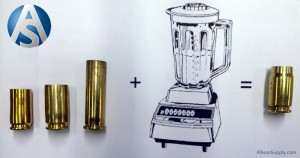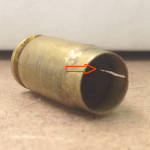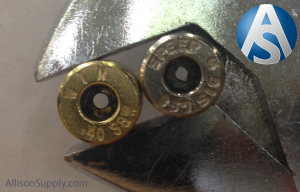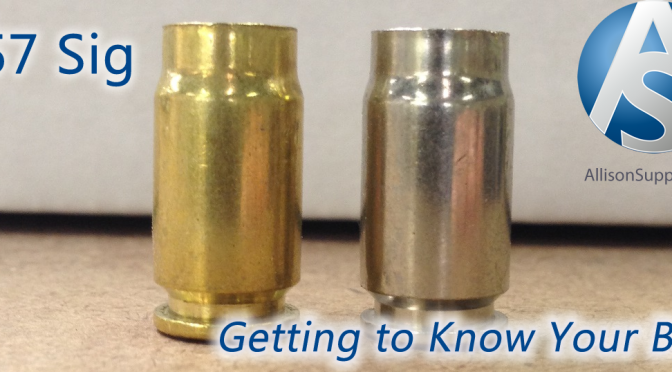357 Sig is a round that maintains its popularity partly out of brand devotion (SIG Sauer), partly out of its use in law enforcement (ready supply of components and familiarity), and mostly because of the benefits and characteristics of the caliber itself. It can be a bear to manage properly, but reloading 357 sig brass is a solid return on time spent, and a great cartridge with which to build your reloading repertoire.
First off, the basics of the .357 cartridge itself: the brass itself is a modified .40S&W that has been necked down to take a 0.355/9mm bullet. (It is worth noting that almost no one suggests necking down a .40S&W to create a .357 Sig brass; the .357 is slightly longer, and the .40S&W host case may catastrophically fail.)  The bottleneck design of the case means that there are almost no feed issues with the round, the ballistics offer significantly more stopping power than a 9mm, and the .357 in a bottleneck case allows for use in semiautomatic pistols rather than revolvers. 357 Sig is handloaded in nickel plated brass almost as frequently as it is loaded in yellow brass cases, a peculiarity due to the crossover from law enforcement use. Typical loads for 357 sig include projectiles ranging from 115gr to 150gr, with FPS in the 1,200 to 1,450fps range, and with
The bottleneck design of the case means that there are almost no feed issues with the round, the ballistics offer significantly more stopping power than a 9mm, and the .357 in a bottleneck case allows for use in semiautomatic pistols rather than revolvers. 357 Sig is handloaded in nickel plated brass almost as frequently as it is loaded in yellow brass cases, a peculiarity due to the crossover from law enforcement use. Typical loads for 357 sig include projectiles ranging from 115gr to 150gr, with FPS in the 1,200 to 1,450fps range, and with
When we see 357 Sig brass that has failed, it is typically a cracked case from near the rim down to below the tapered shoulder of the case (the “bottleneck” of the 357 sig is somewhat notorious for wearing out there first).  While a 357 case won’t last for as many reloads as a 40SW in a fully supported chamber will, it should still serve you well if you start with once fired brass and don’t load incredibly hot rounds. Some 357 sig manufacturers have chosen to tweak their load performance by having smaller than normal flash holes, so when depriming/decamping you should be aware that this is possible and use smaller depriming pins than normal if necessary. The photo shows a standard .40S&W flash hole as compared to the one in the .357 sig flash hole by Speer.
While a 357 case won’t last for as many reloads as a 40SW in a fully supported chamber will, it should still serve you well if you start with once fired brass and don’t load incredibly hot rounds. Some 357 sig manufacturers have chosen to tweak their load performance by having smaller than normal flash holes, so when depriming/decamping you should be aware that this is possible and use smaller depriming pins than normal if necessary. The photo shows a standard .40S&W flash hole as compared to the one in the .357 sig flash hole by Speer.  We’re sure that if you reload in high volume that you’ve broken at least one decapping pin on a 357 sig that sneaked through while loading 40!
We’re sure that if you reload in high volume that you’ve broken at least one decapping pin on a 357 sig that sneaked through while loading 40!
From a value standpoint, 357sig can be a difficult round to find on store shelves, and when you do it is more expensive than the ubiquitous 40SW or its other cousins. The components for 357 sig, however, are easier to come by. We have both yellow brass .357 sig cases and nickel plated .357 brass in our online store; .357 Sig Brass available here, and .357 Sig Nickel Plated Brass available here. 357 sig takes standard small pistol primers, and utilizes (depending on your press manufacturer) many of the same components you’d use for reloading .40 or 9mm.
The weight of fired .357 sig brass cases with the spent primers still in is as follows:
Nickel plated typically ranges from .165 to .167 ounces per piece, or between 10.31 and 10.43 pounds per 1,000 357 nickel casings.
Yellow brass typically ranges from .164 to .167 ounces per piece, or between 10.25 and 10.43 pounds per 1,000 357 sig casings.
Some variation can occur between manufacturers, and the data above is based on once-fired factory loads. With the primers out, .357 sig brass cases approximate .158 ounces each.
If you have any advice or other experience with reloading 357 sig brass, as usual we’d love to hear about it!
